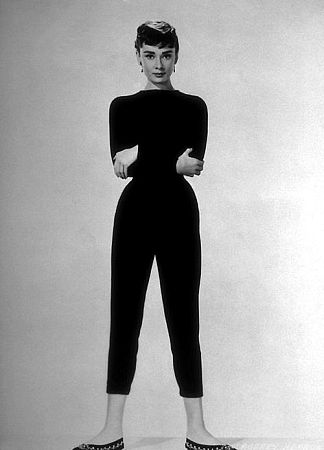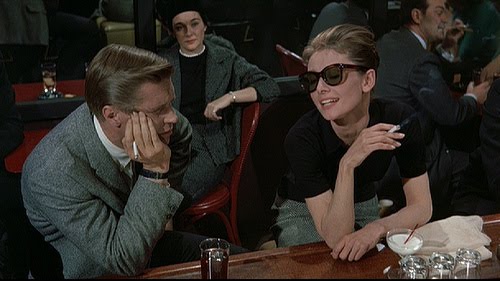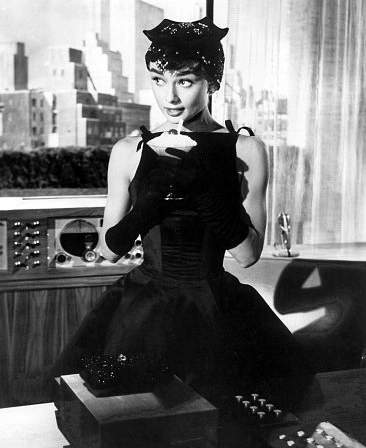 This stunning yet simple black cocktail dress which Audrey Hepburn wore in the 1954 romantic comedy Sabrina is – believe it or not – one of the most controversial frocks in cinema history. It helped to make Sabrina one of the most stylish films of the 1950s – and to establish its young star’s famous chic gamine look. It also marked her first collaboration with Hubert de Givenchy, the French couturier, with whom her style would be inextricably linked for the rest of her life. Being a Cinderella-style love story, Sabrina opens with its heroine dressed in rather dowdier attire, however …
This stunning yet simple black cocktail dress which Audrey Hepburn wore in the 1954 romantic comedy Sabrina is – believe it or not – one of the most controversial frocks in cinema history. It helped to make Sabrina one of the most stylish films of the 1950s – and to establish its young star’s famous chic gamine look. It also marked her first collaboration with Hubert de Givenchy, the French couturier, with whom her style would be inextricably linked for the rest of her life. Being a Cinderella-style love story, Sabrina opens with its heroine dressed in rather dowdier attire, however …
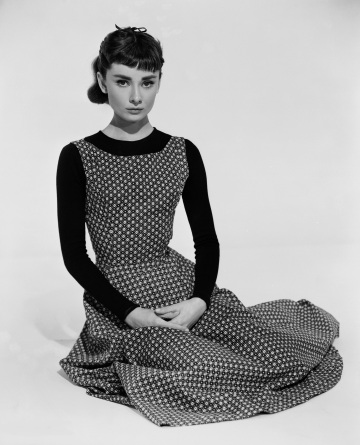 Audrey Hepburn’s wardrobe in Sabrina was originally to be designed by Paramount Studios’ costume supremo, Edith Head. In the film, Sabrina, the chauffeur’s lovesick daughter, goes to Paris as an awkward adolescent and returns transformed into an elegant young lady. Edith Head was put out to learn that, after their first meeting, Audrey had asked director Billy Wilder if she could wear “a real Paris dress” in the film. Mrs Wilder suggested Audrey go to Balenciaga but when the young star turned up, the couturier was too busy see her and sent her to his young friend, Hubert de Givenchy.
Audrey Hepburn’s wardrobe in Sabrina was originally to be designed by Paramount Studios’ costume supremo, Edith Head. In the film, Sabrina, the chauffeur’s lovesick daughter, goes to Paris as an awkward adolescent and returns transformed into an elegant young lady. Edith Head was put out to learn that, after their first meeting, Audrey had asked director Billy Wilder if she could wear “a real Paris dress” in the film. Mrs Wilder suggested Audrey go to Balenciaga but when the young star turned up, the couturier was too busy see her and sent her to his young friend, Hubert de Givenchy.
 Givenchy later recalled: “When the door of my studio opened, there stood a young woman, very slim, very tall, with doe eyes and short hair and wearing a pair of narrow pants, a little T-shirt, slippers and a gondolier’s hat with red ribbon that read ‘Venezia’. I told her: ‘Mademoiselle, I would love to help you, but I have very few sewers. I am in the middle of a collection – I can’t make you clothes.’ Audrey asked to see the collection – and ended up choosing all of Sabrina’s post-Paris capsule wardrobe from it, starting with the super-elegant ensemble with which she wows her childhood crush when she arrives back on Long Island from France.
Givenchy later recalled: “When the door of my studio opened, there stood a young woman, very slim, very tall, with doe eyes and short hair and wearing a pair of narrow pants, a little T-shirt, slippers and a gondolier’s hat with red ribbon that read ‘Venezia’. I told her: ‘Mademoiselle, I would love to help you, but I have very few sewers. I am in the middle of a collection – I can’t make you clothes.’ Audrey asked to see the collection – and ended up choosing all of Sabrina’s post-Paris capsule wardrobe from it, starting with the super-elegant ensemble with which she wows her childhood crush when she arrives back on Long Island from France.
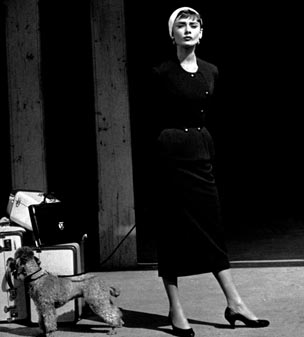
For Sabrina’s first-ever date with David Larabee (the dashing William Holden), the playboy with whom she has been besotted all her life, Audrey (for it really was her choice) selected from Givenchy an exquisite strapless evening gown with a boned bodice and flowing, full, ankle-length skirt. She asked the designer to alter it to that it would hide the hollows behind her collarbone. He later said: “What I invented for her eventually became a style so popular that I named it ‘decollete Sabrina’.”
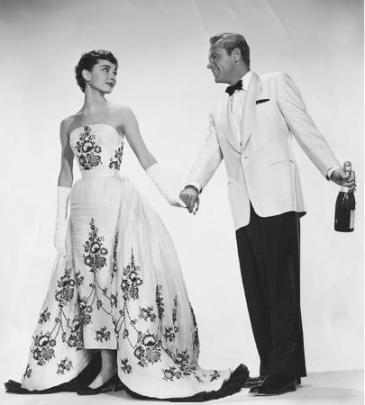 Needless to say, Sabrina is the belle of the ball in her black and white Paris dress. It certainly opens the otherwise-engaged David’s eyes, prompting him to say: “Oh Sabrina, if I’d only known…”. But the “if I’d only known” dress isn’t my favourite from the film; I love the cocktail dress and cute catwoman-like hat that our fickle heroine wears when she’s being romanced by David’s brother, Linus (Humphrey Bogart). What made this cocktail dress so controversial? Well, here’s a clue:
Needless to say, Sabrina is the belle of the ball in her black and white Paris dress. It certainly opens the otherwise-engaged David’s eyes, prompting him to say: “Oh Sabrina, if I’d only known…”. But the “if I’d only known” dress isn’t my favourite from the film; I love the cocktail dress and cute catwoman-like hat that our fickle heroine wears when she’s being romanced by David’s brother, Linus (Humphrey Bogart). What made this cocktail dress so controversial? Well, here’s a clue:
 You would assume that this sketch, by Edith Head, is evidence that she designed the dress which sums up Sabrina’s seductive blend of playfulness and elegance. But that isn’t actually the case – though Head herself allowed the misconception to go uncorrected for the rest of her life. The truth – as explained in Jay Jorgensen’s superb book, Edith Head – The Fifty Year Career of Hollywood’s Greatest Costume Designer (Running Press) – is that Head’s department was supposed to make this dress, with its distinctive bows on the shoulder and boat neck, from a sketch by Givenchy. Jorgensen explains: “Confusion about the designs in the film began as sketches were done in the wardrobe department to execute all the clothing needed. Edith began sending the sketches out to publicize the film, leading to the assumption that all the clothes were her designs.” Here’s Sabrina wearing it on her pre-theatre dinner date at The Colony with Linus.
You would assume that this sketch, by Edith Head, is evidence that she designed the dress which sums up Sabrina’s seductive blend of playfulness and elegance. But that isn’t actually the case – though Head herself allowed the misconception to go uncorrected for the rest of her life. The truth – as explained in Jay Jorgensen’s superb book, Edith Head – The Fifty Year Career of Hollywood’s Greatest Costume Designer (Running Press) – is that Head’s department was supposed to make this dress, with its distinctive bows on the shoulder and boat neck, from a sketch by Givenchy. Jorgensen explains: “Confusion about the designs in the film began as sketches were done in the wardrobe department to execute all the clothing needed. Edith began sending the sketches out to publicize the film, leading to the assumption that all the clothes were her designs.” Here’s Sabrina wearing it on her pre-theatre dinner date at The Colony with Linus.
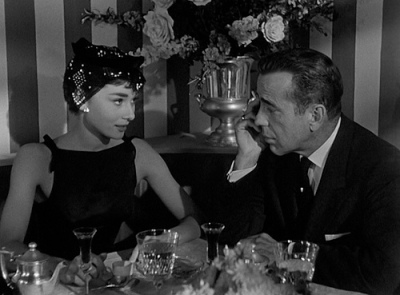 The boat neck of what became known as “The Sabrina Dress” – the design of which was translated into a best-selling dressmaking pattern when the film was released – became a hallmark of the Hepburn look. As did the black legging-like trousers and pumps which she wore, along with a slash-necked top, for a casual visit to Linus’s office.
The boat neck of what became known as “The Sabrina Dress” – the design of which was translated into a best-selling dressmaking pattern when the film was released – became a hallmark of the Hepburn look. As did the black legging-like trousers and pumps which she wore, along with a slash-necked top, for a casual visit to Linus’s office.
It’s only when Sabrina removes her coat – a collarless number which anticipates the Givenchy coats she sports in their classic 1960s collaboration Charade – and turns around that we see the sly sexiness of the ensemble:
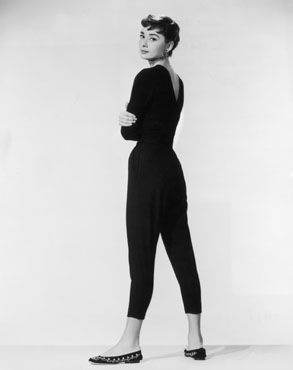 There aren’t that many different outfits in Sabrina – just enough to immediately establish it as a must-see for style lovers. Which must help explain why Edith Head presumably kept quiet about the extent of Givenchy’s involvement in the film and the fact that, with Audrey, he created Sabrina’s Parisian-inspired look, the look that dominates the movie. Not only did Givenchy’s name appear nowhere in the credits, but Head accepted an Oscar for Sabrina and didn’t even acknowledge the French designer’s contribution to the film.
There aren’t that many different outfits in Sabrina – just enough to immediately establish it as a must-see for style lovers. Which must help explain why Edith Head presumably kept quiet about the extent of Givenchy’s involvement in the film and the fact that, with Audrey, he created Sabrina’s Parisian-inspired look, the look that dominates the movie. Not only did Givenchy’s name appear nowhere in the credits, but Head accepted an Oscar for Sabrina and didn’t even acknowledge the French designer’s contribution to the film.
 According to Jorgensen’s book, Head even had the gall to parade the original dress down the runaways of her fashion shows. It was only after Head’s 1980 death, that Givenchy, a true gentleman, finally confirmed that the dress had been his design but had been made under Head’s supervision at Paramount…
According to Jorgensen’s book, Head even had the gall to parade the original dress down the runaways of her fashion shows. It was only after Head’s 1980 death, that Givenchy, a true gentleman, finally confirmed that the dress had been his design but had been made under Head’s supervision at Paramount…

